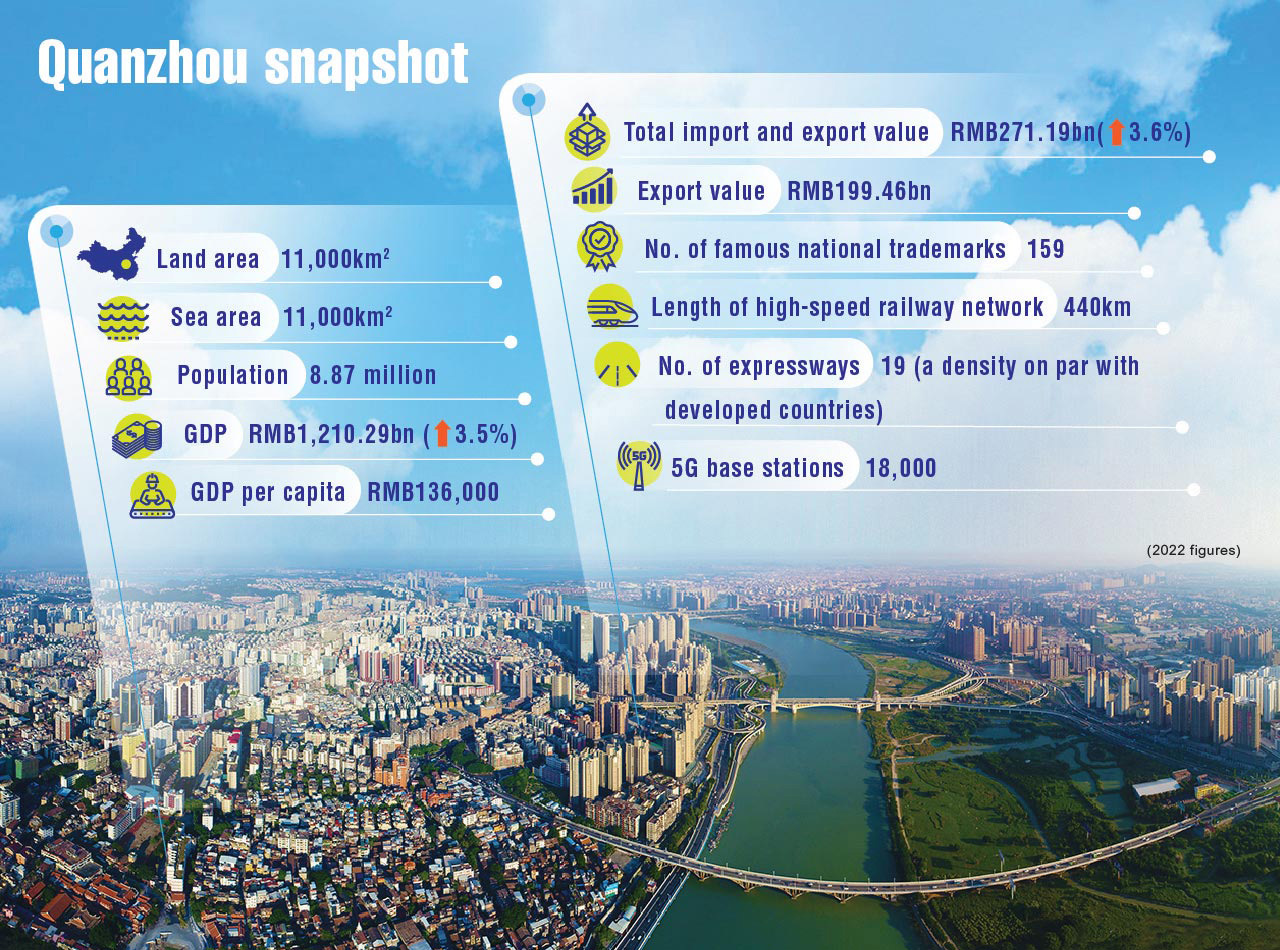
Quanzhou in Fujian province boasts abundant cultural and natural resources. [Photo provided to enquanzhou.com]
Quanzhou, located in the southeast of Fujian province, is one of the three major central cities of Fujian. The city is south of Fuzhou, the provincial capital, north of Xiamen, east of Zhangzhou, Longyan and Sanming, and with Taiwan to the east. It has jurisdiction over four districts (Licheng, Fengze, Luojiang and Quangang), three county-level cities (Jinjiang, Shishi and Nan'an), and five counties (Huian, Anxi, Yongchun, Dehua and Jinmen [to be unified]). It is also home to Quanzhou Economic and Technological Development Zone and Quanzhou Taiwan Investment Zone.
The city covers 11,015 square kilometers (including Jinmen) and by the end of 2018 had a permanent population of 8.7 million (excluding Jinmen). According to the sixth national census in 2010, there are 53 ethnic minorities in the city, with the largest being the Hui, Tujia, Miao and She. Quanzhou dialect is based on Minnan (southern Fujian) dialect and the common language is mandarin.
Topography
Quanzhou stands in front of mountains and faces the sea. Hills, valleys and basins are scattered throughout the city. Its terrain is high in the northwest and low in the southeast. There are more than 667,000 hectares of mountainous land in Quanzhou, taking up 80 percent of its land.
Coasts and ports
Quanzhou has sea area of 11,360 sq km, a 541-km-long coastline, 14 large and small harbors and 207 islands. Most of the harbors are deep water harbors which provide 123 deep water berths of more than 10,000 tons. Xiaocuo and Douwei ports on the south shore of Meizhou Bay are rare natural harbors in China and even the world. The area of marine fishing grounds is more than 5,000 sq km, 118 sq km of which can be exploited. There are more than 500 kinds of main aquatic organisms, nearly 100 kinds of main commercial fish, and more than 200 kinds of oysters, mussels, clams, snails, kelp, laver and other shellfish and algae.
Climate
Quanzhou features a subtropical oceanic monsoon climate, with warm and humid weather throughout the year. The annual average temperature is 19.5-22 C. The four seasons in Quanzhou are all like spring, so Quanzhou has been dubbed "Wenling" (warm mountainous area).
Resources
Quanzhou's forest growing stock is about 40.18 million cubic meters. Quanzhou has proven reserves of more than 130 mineral deposits, including eight large ones. The main mineral resources include more than 30 kinds, such as kaolin, granite, diabase, quartz sand, limestone, coal, iron, manganese, geothermal and mineral water.
The city receives abundant rainfall throughout the year. There are 34 streams with a total length of 1,620 km. Quanzhou's surface water totals 8.76 billion cubic meters, available water of 1.46 billion cu m, and hydropower reserves up to 430,000 kilowatts.
Jinjiang River is the largest river in Quanzhou, originating from the southeast foot of Daiyun Mountain, running through Yongchun, Anxi, Nan'an, Licheng and Jinjiang, and finally into Quanzhou Bay. The river system is 404.8 km long, with a drainage area of 5,629 sq km. In addition, Quanzhou has one billion cu m of groundwater resources, and 76 million cu m of available groundwater.
Humanity history
Quanzhou has a long history and its economic development began as early as the Zhou Dynasty (c.11th century-256 BC). In 260, during the Three Kingdoms period (220-280), Dongan county was established in today's Fengzhou town in Nan'an, which marked the start of Quanzhou's prefecture system.
At the end of the Western Jin Dynasty (265-316), due to wars in the central plains area, many people moved into Quanzhou and settled along the river. The river has been called Jinjiang ever since. The people brought advanced production technology and cultural knowledge, which led to rapid development on both sides of the river.
With the development of the economy, the administrative division system in Quanzhou changed several times. In January 1986, Quanzhou prefecture-level city was set up.
Quanzhou is one of the famous historical and cultural cities approved by the State Council, Culture City of East Asia, and the starting point of the ancient Maritime Silk Road. With profound cultural accumulation, Quanzhou is known as the "world museum of religions".
The city has 824 cultural relic protection units at all levels, including 31 at the national level and 87 at the provincial level. Renowned cultural relics include the oldest existing mosque in China, the thousand-year-old Kaiyuan Temple, and the oldest existing cross-sea girder bridge in China, Luoyang Bridge.
The rich cultural landscape, unique folk customs and natural scenery make Quanzhou a national and international tourist resort, attracting more and more tourists from across the world.
Quanzhou was an important port for foreign trade in Chinese history, with an over-1,000-year history of overseas transport. Since the Tang Dynasty (618-907), it has been one of the four major foreign trade ports in southern China. During the Song (960-1279) and Yuan (1271-1368) dynasties, Quanzhou port rose to be the first of the four major ports, known as Zayton Port worldwide, and became the "largest port in the east" comparable to Alexandria in Egypt.
Quanzhou is also a famous hometown of overseas Chinese and the main ancestral home of Taiwan Han compatriots. Quanzhou is the ancestral home of over 7.2 million overseas Chinese living around the world, over 700,000 compatriots in Hong Kong and Macao, and over nine million compatriots of the Han ethnic group in Taiwan. Many of these people invest in plants, schools and public projects in Quanzhou. They have become an important force in the economic and social development of the city, and a link between Quanzhou and the world.
Economic development
Since China's reform and opening-up began in 1978, Quanzhou's economy has achieved leap frog development, becoming one of the fastest growing and most dynamic areas in China, as well as officially one of the 18 typical areas of reform and opening-up in China.
Quanzhou's GDP in 1978 was 779 million yuan ($111 million), 10 billion yuan in 1992, 100 billion yuan in 2002, 500 billion yuan in 2013 and 994.67 billion yuan in 2019. Total revenue in the general public budget increased from 80 million yuan to 83.9 billion yuan. In 1978, the per capita net income of rural residents was only 75 yuan, and in 2019 the disposable income of rural residents was 22,142 yuan. The per capita disposable income of urban residents increased from 324 yuan in 1978 to 49,592 yuan.
Quanzhou is striving to build a characteristic economy, promoting characteristic industries such as resin processing, shoes and garments, building materials, stone carving and oolong tea in China and around the world.
The process of urban and rural integration has been accelerated by professionalization, localization, regionalization and clustering of production, which have led to the construction and prosperity of Quanzhou. The city's urbanization level is 65.7 percent, the bay area is 220 sq km, and central urban green coverage is 43.2 percent, with a complete three-dimensional traffic network and municipal facilities. Quanzhou is among the three central cities in Fujian province.
Besides economic development, Quanzhou pays special attention to its culture and urban construction. The city has won various titles and honors such as International Garden City, National Civilized City, National Sanitary City and National Garden City.
The coastal city of Quanzhou has a unique advantage in developing its marine economy. [Photo/people.com.cn]









